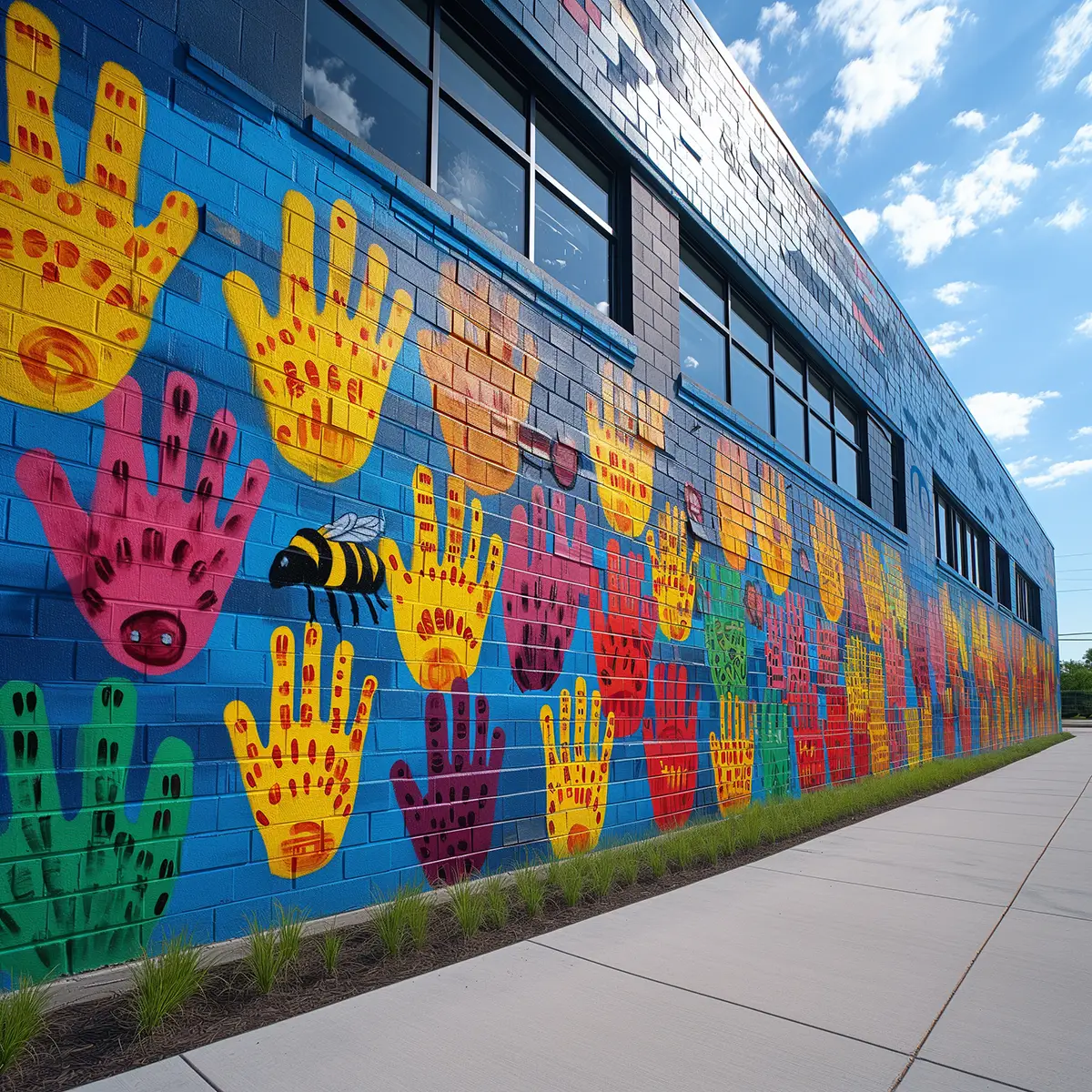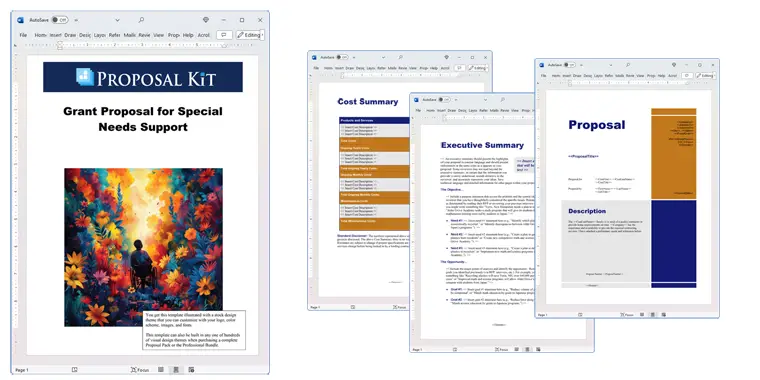How to write your Grant Proposal for Special Needs Support
We include this 20 page layout with every Proposal Pack. If you want this template to have a different visual design theme than the one illustrated here, purchase any Proposal Pack design and create this template using the purchased design theme. This template is included in every Proposal Pack. If you get a Proposal Pack or the Professional, you can also make any variation of this template with different chapters to suit your needs.
We typically include more chapters in the templates than most people will need to give everyone more variety in the chapters they may need. You can trim down a long template by removing pages you do not need or combining multiple chapter topics into one page.
 DOWNLOADABLE, ONE-TIME COST, NO SUBSCRIPTION FEES
DOWNLOADABLE, ONE-TIME COST, NO SUBSCRIPTION FEESYou can also create countless variations of this document to suit your needs using the included library of 2200+ chapters if ordering a Proposal Pack or Professional.
 What Our Clients Say
What Our Clients SayAs a business consultant who applied for funding on behalf of organizations, the proposal pack wizard provide me with all the materials I needed to submit many grant awarding proposals. Not only did I save on time but the financial costs were kept to a minimum. I would definitely use this product every time I needed to write a proposal."
Related Article
Related Video
Related Templates
- Educational Grant Proposal #2
- Daycare Preschool Grant Funding Proposal
- Mental Health Grant Funding Proposal
- Art Therapy Grant Proposal
- Educational Grant Proposal
- Non-profit Support Proposal
- Grant Funding Request Proposal
- School Improvement Project Proposal
- Educational Training for Special Needs Proposal
- Medical Clinic for Community Funding Proposal
- STEM Educational Program Proposal
- School Funding Request Proposal
- DOE Federal Government Grant Proposal 2
- Teen Center Funding Proposal
- Mental Health Proposal Template
- Healthcare Provider Grant Proposal
- Audio Visual Production Proposal
- Fundraising Support Proposal
- DOE Federal Government Grant Proposal
- Online School and Media Outlet Funding Proposal
What's the Best Way to Write Your Grant Proposal for Special Needs Support?
A proven way to write your grant proposal for special needs support is using the Proposal Kit template and software package. Proposal Kit offers a comprehensive library of templates and an intuitive software system that simplifies creating detailed and professional proposals. These tools are designed to help businesses and organizations, especially those with little to no experience in proposal writing, create winning proposals that can win grants and contracts.
The Proposal Kit system also incorporates a line item quoting database system that streamlines the inclusion of cost summaries, quotes, estimates, budgets, and other financial details.
You're not alone if you need to write a grant proposal for special needs support. Many people need help with creating detailed and persuasive proposals that meet the rigorous standards of grant applications. Here's how you can tackle this challenge.
What Types of Projects Are Grant Proposals for Special Needs Support Written For?
Grant proposals for special needs support can cover a wide range of projects. Here are some examples of such projects:
- Submitting a grant proposal to foundations focused on education
- Applying for government funding for special needs programs
- Requesting donations from private donors or corporations
- Seeking partnerships with other educational institutions
- Justifying budget increases for school boards or districts
- Developing internal funding proposals for non-profits
- Creating a framework for future grant applications
- Demonstrating organizational commitment to potential partners
- Establishing credibility with stakeholders and community members
- Showcasing successful methodologies for special needs education
- Advocating for policy changes in educational institutions
- Reporting project outcomes to existing funders
- Training new staff on the goals and methods of the project
- Creating marketing materials to garner additional support
- Enhancing donor relations by demonstrating accountability
- Publishing a case study on grant-funded projects
- Presenting at educational conferences or seminars
- Facilitating workshops on special needs education
- Networking with other organizations focused on disabilities
- Building a repository of resources for ongoing and future initiatives
Chapters this template is built with
There is no one-size-fits-all template that works for every use case. Instead, you can customize your proposal using the Proposal Kit's extensive library of thousands of chapters. Below is a starting point for the essential chapters that can be included in your proposal
This provides a detailed guide for creating each section of a grant proposal for special needs support, ensuring that each part of the proposal is comprehensive and tailored to the project's specific needs.
This list is just a small selection of the thousands of templates in the Proposal Kit's library. You can customize your proposal to cover all topics necessary for your project. Once the proposal is complete, it can be saved in PDF format for delivery.
Cover Letter
The cover letter introduces your proposal and outlines its purpose. It should be professional and briefly explain the significance of your project. For a grant proposal for special needs support, mention the specific educational institution or foundation you are targeting and highlight the critical need for support for visually impaired students. Explain how your project aligns with the funder's mission and goals.
Introduction
Provide an overview of your project, including its purpose and importance. This sets the stage for the detailed sections to follow. For special needs support, outline the scope of your project, such as developing accessible learning materials or implementing specialized training programs for teachers. Emphasize the importance of inclusivity in education and how your project aims to enhance learning experiences for students with special needs.
Problem Statement
Detail the specific problem your project aims to address, supported by data and research. This shows the funders the need for your project. Considering the situation of special needs support, describe the challenges visually impaired students face in the educational system. Use statistics and studies to highlight gaps in resources and support. Explain how these issues impact students' academic performance and overall well-being.
Executive Summary
Summarize your proposal's key points, including the project's objectives, methods, and expected outcomes. This gives reviewers a quick overview. For a special needs support proposal, briefly outline your plan to address the identified problems, the strategies you will employ, and the anticipated benefits for visually impaired students. Mention any key partnerships or endorsements that strengthen your proposal.
Cost Summary
Outline the estimated costs of your project, including all necessary expenditures. This ensures transparency in how the funds will be used. Provide a detailed breakdown of the expenses for developing accessible materials, training programs, assistive technology, and other related costs. Show that your budget is well-researched and realistic, ensuring funders will use their money effectively.
Needs Assessment
Explain the needs of the target population and how your project will meet those needs. Use data and research to support your assessment. For special needs support, discuss the specific needs of visually impaired students and how current resources fall short. Use surveys, interviews, and other research methods to gather data on these needs. Show how your project is tailored to address these specific gaps.
Goals and Objectives
Define the specific goals and objectives of your project. This section should clearly state what you aim to achieve. For a grant proposal for special needs support, set clear, measurable goals such as increasing the accessibility of educational materials, enhancing teacher training in special education, and improving academic outcomes for visually impaired students. Detail the steps you will take to achieve these goals.
Expected Results
Describe the expected outcomes and impact of your project. This helps funders understand the potential benefits of supporting your initiative. For special needs support, outline the positive changes you anticipate, such as improved academic performance, increased engagement, and better support systems for visually impaired students. Provide metrics for success, such as the number of students reached or improvements in test scores.
Methodology
Detail the methods and strategies you will use to achieve your project goals. This section should provide a clear plan of action. Describe the specific interventions you will implement for special needs support, such as creating accessible textbooks, providing assistive technology, or conducting teacher training workshops. Explain how these methods are based on best practices and research in special education.
Project Background
Provide context and background information about your project, including any preliminary work or pilot studies. This establishes the foundation of your proposal. For a grant proposal for special needs support, discuss any previous projects or pilot programs you have conducted that relate to your current proposal. Highlight successes and lessons learned, demonstrating your capability to manage and execute similar initiatives.
Reporting
Explain how you will report on the progress and outcomes of your project. Regular reporting builds trust with funders. For special needs support, outline your plan for tracking and documenting the project's progress, including regular updates, financial reports, and impact assessments. Specify the frequency and format of these reports, ensuring transparency and accountability.
Special Needs
Detail how your project addresses special needs issues. This is crucial for proposals focused on exceptional education support. Explain how your project will create an inclusive environment for visually impaired students, including using specialized materials, adaptive technology, and tailored teaching strategies. Highlight the benefits of these interventions for enhancing learning experiences.
Disabilities
Provide specific information on how your project will support individuals with disabilities. This includes accommodations and resources. Describe the tools and resources you will provide for special needs support, such as Braille books, screen readers, or magnification devices. Explain how these accommodations will be integrated into the classroom and improve access to education for students with visual impairments.
Evaluation
Describe how you will evaluate the success of your project and measure its impact. A robust evaluation plan demonstrates accountability. For special needs support, outline the metrics and methods you will use to assess the effectiveness of your interventions, such as student performance data, feedback from teachers and students, and pre-and post-intervention assessments. Explain in detail how you will use this data to make ongoing improvements.
Project Summary
Summarize the critical aspects of your project, highlighting its significance and potential impact. For a grant proposal for special needs support, restate the importance of your project in addressing the educational needs of visually impaired students. Summarize your goals, methods, expected outcomes, and the positive impact on the target population.
Beneficiaries
Identify the beneficiaries of your project and how they will benefit. This section should clearly show who will be helped and in what ways. For special needs support, describe the visually impaired students who will directly benefit from your project and the broader impact on teachers, families, and the educational institution. Highlight the long-term benefits of improved accessibility and inclusivity.
Mission Statement
Include your organization's mission statement to align your project with your overall goals and values. For special needs support, ensure your mission statement reflects a commitment to inclusivity, accessibility, and supporting individuals with disabilities. Show how your project aligns with and advances your mission.
Use cases for this template
Securing Funding for Accessible Educational Materials
Jake, a small business owner of EduTech Solutions, needed to secure a grant to develop accessible educational materials for visually impaired students. With no experience writing grant proposals, he felt overwhelmed. Jake turned to Proposal Kit and found a template for special needs support projects.
Using the Proposal Kit template, Jake created a comprehensive proposal. The template guided him in including detailed cost summaries, a clear outline of his project, and testimonials from educators who had previously used his materials. Jake also used the line item quoting database system to detail his costs and project expenses accurately.
The Proposal Kit's intuitive software allowed Jake to tailor each section to meet the grant's specific requirements, ensuring his proposal was professional and compliant with the funding agency's standards. Once completed, he submitted his polished proposal. The result was a winning proposal that secured new funding, enabling EduTech Solutions to develop and distribute accessible educational materials, greatly benefiting visually impaired students.
Meeting a Tight Deadline
Mia, an employee at PlaySafe Inc., was tasked with submitting a proposal for a grant to build an inclusive playground. Faced with a tight deadline and the pressure to produce a high-quality proposal, Mia turned to Proposal Kit for a solution.
Mia used the Proposal Kit with limited time to quickly create a professional proposal. She leveraged the templates to structure the proposal, ensuring all necessary components were covered, from the needs assessment and goals to the budget and unique needs accommodations. Mia also used an AI writing tool to help draft specific chapters to expedite the writing process. This tool analyzed PlaySafe Inc.'s website and existing documents to create content aligned with the company's strengths and experience.
The combination of Proposal Kit's templates and the AI tool enabled Mia to meet her deadline. The funding agency received the proposal well and appreciated the clear, detailed, and professional presentation. As a result, PlaySafe Inc. won the grant, boosting the company's reputation and enabling it to create a much-needed inclusive playground in the community.
Creating a Winning Proposal for TeachWell
Liam, a director at TeachWell, a company specializing in special education training programs, needed to write a grant proposal to secure funding for a new teacher training initiative. Writing a proposal for the funding agency was complex, and Liam wanted to ensure his proposal was detailed and compelling.
He turned to Proposal Kit to create his proposal. The extensive template library provided him with various sections, including company history, methodology, and special needs support. Liam used these templates to create a well-structured and professional proposal highlighting TeachWell's past successes, specialized training services, and commitment to improving special education.
With the help of the Proposal Kit, Liam produced a comprehensive proposal that detailed TeachWell's unique methodologies and benefits of training programs. He included specific examples of previous successful initiatives and demonstrated how TeachWell could meet the funding agency's goals.
The polished proposal was submitted and attracted positive attention. TeachWell won the grant, securing new funding and reinforcing the company's position as a leading provider of special education training programs. This grant boosted TeachWell's credibility and expanded its influence in promoting inclusive education.
Conclusions and Recommendations
Writing a grant proposal for special needs support using the Proposal Kit template and software package makes the process much more manageable. Proposal Kit provides the tools and templates to create a professional and persuasive proposal. Proposal Kit helps you save time, reduce stress, and increase your chances of winning the grant proposal for special needs support.
Also Known As
This template may also be referred to in different ways or be used in more specialized situations, such as:
- Special Needs Grant Application
- Special Education Funding Proposal
- Inclusive Education Grant Submission
- Special Needs Funding Request
- Disability Support Grant Proposal
- Special Needs Program Grant Bid
- Special Needs Assistance Proposal
- Accessibility Improvement Funding Request
- Special Needs Project Proposal
- Disability Services Grant Application
Abstract
 The process of creating a successful grant proposal for special needs support can be overwhelming, especially for those inexperienced in grant writing. The Proposal Kit offers an invaluable solution, providing a comprehensive library of templates and intuitive software designed to assist businesses, nonprofits, and government agencies. These tools help in creating detailed proposals for securing federal funding and special education grants under the Disabilities Education Act. By using this system, organizations can communicate the financial resources and support needed to significantly enhance the lives of students with disabilities, such as those with cerebral palsy.
The process of creating a successful grant proposal for special needs support can be overwhelming, especially for those inexperienced in grant writing. The Proposal Kit offers an invaluable solution, providing a comprehensive library of templates and intuitive software designed to assist businesses, nonprofits, and government agencies. These tools help in creating detailed proposals for securing federal funding and special education grants under the Disabilities Education Act. By using this system, organizations can communicate the financial resources and support needed to significantly enhance the lives of students with disabilities, such as those with cerebral palsy.
The Proposal Kit simplifies the inclusion of financial details, ensuring transparency and professionalism. It assists in identifying areas of need, recruiting colleagues, and collaborating with nonprofits and other educational institutions. The kit provides guidance on fulfilling proposals' requirements, protecting funding sources, and engaging sponsors. Whether it's for developing accessible educational materials, inclusive playgrounds, or special training programs for special education professionals, the Proposal Kit aids in preparing a proposal that aligns with funders' missions and goals.
Organizations can use these resources to support students across various types of disabilities and ages, from birth to youth. By offering professional development, in-kind contributions, and evidence-based methodologies, proposals created with the Proposal Kit can demonstrate a strong organizational commitment to addressing the needs of children with physical disabilities. This enables the creation of an inclusive learning environment and provides the necessary equipment and support to enhance the educational experience for all learners. By using these tools, proposals can showcase successful methodologies, advocate for policy changes, and establish credibility with stakeholders, ensuring that the lives of students and the broader community are improved through well-allocated financial support.
 Using Proposal Kit not only streamlines the creation of grant proposals but also helps organizations produce documents that adhere to the guidelines set forth by funding bodies. This is crucial when addressing the stringent requirements often associated with the Disabilities Education Act. By facilitating a structured approach, the Proposal Kit allows grant writers to focus on highlighting the specific needs of individuals with physical disabilities, thus making a case for financial support.
Using Proposal Kit not only streamlines the creation of grant proposals but also helps organizations produce documents that adhere to the guidelines set forth by funding bodies. This is crucial when addressing the stringent requirements often associated with the Disabilities Education Act. By facilitating a structured approach, the Proposal Kit allows grant writers to focus on highlighting the specific needs of individuals with physical disabilities, thus making a case for financial support.
The Proposal Kit is particularly beneficial for nonprofit organizations and educational departments seeking to collaborate on initiatives that address the needs of children with disabilities. These collaborations can leverage in-kind contributions and available resources to enhance the quality of life for students. By enabling organizations to identify areas in need of development and support, the Proposal Kit fosters a proactive search for innovative ideas that engage stakeholders and sponsors alike.
Moreover, the Proposal Kit aids in establishing relationships between organizations and entities like the National Center for Special Education Research or relevant government bureaus. This collaboration can lead to increased support for projects that align with the shared mission of improving educational inclusivity. Parents and educators, as primary stakeholders, also stand to benefit from such initiatives, as these proposals can lead to improved resources and support systems that directly impact students' academic and social experiences.
 Overall, the Proposal Kit is more than just a tool - it's a catalyst for change that helps organizations navigate the complex landscape of grant writing. It connects various entities in a collaborative effort to secure the necessary funding and resources needed to bring about meaningful improvements in the field of special education.
Overall, the Proposal Kit is more than just a tool - it's a catalyst for change that helps organizations navigate the complex landscape of grant writing. It connects various entities in a collaborative effort to secure the necessary funding and resources needed to bring about meaningful improvements in the field of special education.
The Proposal Kit serves as an important resource in the field of special education, particularly under the framework of the Disabilities Education Act. By enabling organizations to structure their grant proposals, it helps secure funding for initiatives that directly benefit individuals with physical disabilities. The Proposal Kit's comprehensive approach ensures that every topic of a proposal aligns with the specific requirements of both funding bodies and the unique needs of the target population.
One of the advantages of using Proposal Kit is its ability to highlight the importance of in-kind contributions. These contributions, whether in the form of equipment, expertise, or time, play a significant role in the successful implementation of special education programs. By emphasizing these contributions within a proposal, organizations can showcase a broader commitment to their initiatives, strengthening their case for financial support.
 Furthermore, the involvement of entities like the National Center for Special Education Research can enhance the credibility and reach of proposed projects. By integrating research-backed practices and data, proposals created using the Proposal Kit can demonstrate an evidence-based approach to addressing the challenges faced by students with physical disabilities.
Furthermore, the involvement of entities like the National Center for Special Education Research can enhance the credibility and reach of proposed projects. By integrating research-backed practices and data, proposals created using the Proposal Kit can demonstrate an evidence-based approach to addressing the challenges faced by students with physical disabilities.
The ultimate beneficiaries of these well-written proposals are the students and their families. Parents, in particular, gain peace of mind knowing that their children have access to improved educational resources and support systems. As organizations continue to use the Proposal Kit to advocate for better funding and resources, they contribute to a more inclusive and supportive educational environment where every child has the opportunity to succeed and thrive.
Frequently Asked Questions
What are key components of a grant proposal for special needs support?
Key components include the cover letter, introduction, problem statement, executive summary, cost summary, needs assessment, goals and objectives, expected results, methodology, project background, reporting, special needs, disabilities, evaluation, project summary, beneficiaries, and mission statement. Using Proposal Kit's templates ensures all these components are covered.
How can Proposal Kit help me with cost summaries and quotes?
Proposal Kit incorporates a line item quoting database system that simplifies the inclusion of cost summaries, quotes, estimates, and budgets in your proposal, ensuring accuracy and professionalism.
Can I customize the Proposal Kit templates to fit my needs?
Yes, Proposal Kit offers an extensive library of thousands of templates that can be customized to fit your project's and proposal's unique requirements.
How do I convert my proposal to a PDF format for submission?
Once you have finished editing your proposal in the Proposal Kit template, you can easily save it as a PDF file, ensuring it is in the correct format for submission.
What types of projects can benefit from using Proposal Kit for special needs support?
Projects such as developing accessible educational materials, creating inclusive playgrounds, providing assistive technology, implementing special education training, establishing support services for autism, conducting research, building sensory rooms, offering counseling, funding scholarships, and organizing workshops can all benefit from using the Proposal Kit to create professional grant proposals.
20% Off Discount
![]() Add To Cart This Word Template
Add To Cart This Word Template
 Add To Cart Proposal Pack for Any Business
Add To Cart Proposal Pack for Any Business
 Add To Cart Proposal Kit Professional
Add To Cart Proposal Kit Professional
 4.7 stars, based on 849 reviews
4.7 stars, based on 849 reviewsProposal Kit chapters used in this template
Cover Letter, Title Page, Table of Contents, Introduction, Problem Statement, Executive Summary, Project Background, Needs Assessment, Beneficiaries, Special Needs, Disabilities, Goals and Objectives, Methodology, Reporting, Expected Results, Cost Summary, Evaluation, Project Summary, Mission Statement, Back Page
Line Item Automated Chapters
If you purchase a Proposal Pack or the Professional Bundle, these proposal pages are generated using an automated line-item database in the included Wizard software.
Cost Summary
You use this proposal for
- General business proposal
- Education, training proposal
- Non-technical proposal
- Project pitch proposal
- Non-government grant, non-profit, NGO proposal
- RFP response
- Medical, healthcare, wellness proposal
- State, county or local government grant proposal
How to create this template with Proposal Pack Wizard
You can create this document using any of the logo-designed Proposal Packs. Pick any Proposal Pack with a logo design theme you like best; they will all work equally well. The Proposal Pack for Any Business is the pack with no extra added logos or colors - designed to be used plain or for you to customize with your logos and graphics.
The Proposal Pack design theme you purchase will determine the visual look of this template. The screenshot above only shows the plain generic design theme.
We include a library of chapters to be assembled based on your needs. All proposals are different and have different needs and goals. We designed Proposal Pack so you can customize the documents to suit your needs.
You will best create this document using the Proposal Pack Wizard - Expert Edition software to select this template and build it in the Proposal Pack logo design theme of your choice along with any desired customizations (such as adding additional chapters, removing unneeded chapters, changing the order of chapters, and importing your company logo). This template outlines a proposal for the described situation. Each user is responsible for typing in the actual content of the provided pages with their information to complete the proposal. Suggestions in the abstract may include features in higher-end packages and are facilitated by the selection of chapter templates to support the narrative of each proposal, which help guide the user in filling in the details.
The Wizard software's AI Writer will write the content of the pages of the template based on details provided for your company, client, project, financial details and other writing instructions. This will provide a personalized version of the template completely written and ready to edit.
Once finished, the AI Writer's Word-to-PowerPoint converter can transform your proposal, business plan, or other business documents into a PowerPoint slideshow. Save time and effort by letting the AI analyze every chapter to condense its content into talking points, visually matching the document, and providing a consistent package of presentation material with the click of a button.
You create this template using the Wizard software with an entire Proposal Pack library and software. We include the Expert Edition of the software in the Proposal Kit Professional. Microsoft Word for Windows is required to use the customizing software. You can also edit Word document templates in other office software such as Word for Mac. We will assist Mac users in assembling complex templates for their first project if they do not have the required platform to run the Wizard software.
How to Build Templates Featured on Proposal Kit Website
Many people find the Proposal Kit website after searching for a specific proposal. Once you've purchased and installed the software, how do you build that template you found in the first place? This video shows you how to build any proposal you see on the Proposal Kit website.
 Ian Lauder has been helping businesses write their proposals and contracts for two decades. Ian is the owner and founder of Proposal Kit, one of the original sources of business proposal and contract software products started in 1997.
Ian Lauder has been helping businesses write their proposals and contracts for two decades. Ian is the owner and founder of Proposal Kit, one of the original sources of business proposal and contract software products started in 1997.By Ian Lauder
 Published by Proposal Kit, Inc.
Published by Proposal Kit, Inc.


 Cart
Cart
 Get 20% off ordering today:
Get 20% off ordering today: 


 Facebook
Facebook YouTube
YouTube Bluesky
Bluesky Search Site
Search Site